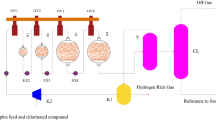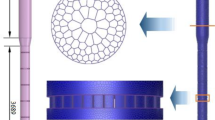Abstract
The present work is an attempt to develop a mathematical model which describes the production of aromatics and hydrogen in the naphtha platforming unit of the refinery of Skikda in Algeria. The process is carried out in a cascade of four cylindrical different sized reactors. The mathematical model is based on the assumption that the system is a non-isothermal heterogeneous four fixed bed reactors with a catalytic pellet that contains two metallic catalysts and an acidic catalyst. These catalysts are assumed to be distributed, throughout the pellet, in a non uniform way. The metallic catalysts are Platinum (Pt) and Rhenium (Re). Furthermore, an axial dispersion and resistances to mass and thermal transfers have been considered in this model. The results from the simulation of the model were compared to industrial results, at the start of the cycle well before any deactivation process has taken place, obtained from the naphtha platforming unit of the refinery of Skikda in Algeria. This comparison was carried out in order to validate the model. This led to good agreement between the simulation results and the industrial results. Under the same conditions of validation but with a change in catalyst distributions, the simulated results show an enhancement in the production of aromatics, hydrogen and light products. The simulated results also showed that the fourth reactor is not necessary.




Similar content being viewed by others
References
Antos GJ, Aitani AM, Parra JM (1995) Catalytic naphtha reforming. Marcel Dekker Inc, New York
Raseev S (2003) Thermal and catalytic processes in petroleum refining. Marcel Dekker Inc, New York
George JA, Abdullah MA (2004) Catalytic naphtha reforming, 2nd edn. Marcel Dekker, New York
Smith R (1959) Kinetic analysis of naphtha reforming with platinum catalyst. Chem Eng Prog 55(6):76–80
Krane HG, Groh AB, Schuhnan BL, Sinfeh JH (1960) Reactions in catalytic reforming of naphthas, Paper presented in Fifth World Petroleum Congress
Henningsen J, Bundgaard-Nielson M (1970) Catalytic reforming. Br Chem Eng 15:1433–1439
Ancheyta J, Aguilar E (1994) New model accurately predicts reformate composition. Oil Gas J 31:93–95
Ancheyta-Juarez J, Villafuerte-Macias E (2000) Kinetic modeling of naphtha catalytic reforming reactions. Energy Fuels 14:1032–1037
Rodriguez MA, Ancheyta J (2011) Detailed description of kinetic and reactor modeling for naphtha catalytic reforming. Fuel 90:3492–3508
Taskar U, Riggs JB (1997) Modeling and optimization of a semi-regenerative catalytic naphtha reformer. AIChE J 43(3):740–753
Lee JW, Ko YC, Jung YK, Lee KS, Yoon ES (1997) A modeling and simulation study on a naphtha reforming unit with a catalyst circulation and regeneration system. Comput Chem Eng 21:S1105–1110
Lid T, Skogestad S (2008) Data reconciliation and optimal operation of a catalytic naphtha reformer. J Process Control 18:320–331
Padmavathi G, Chaudhuri KK (1997) Modeling and simulation of commercial catalytic naphtha reformers. Can J Chem Eng 75(5):930–937
Fazeli A, Fatemi S, Mahdavian M, Ghaee A (2009) Mathematical modeling of an industrial naphtha reformer with three adiabatic reactors in series. Iran J Chem Eng 28(3):97–102
Hongjun Z, Mingliang S, Huixin W, Hongbo ZL, J, (2010) Modeling and simulation of moving bed reactor for catalytic naphtha reforming. Pet Sci Technol 28:667–676
Khosrozadeh I, Talaghat MR, Roosta AA (2018) Optimization of semi regenerative catalytic naphtha reforming unit to enhance octane number and reformate yield. IAChEJ 15(2):52–64
Rahimpour MR (2009) Enhancement of hydrogen production in a novel fluidized- bed membrane reactor for naphtha reforming. Int J Hydrogen Energy 34:2235–2251
Rahimpour MR, Iranshahi D, Bahmanpour AM (2010) Dynamic optimization of a multi-stage spherical, radial flow reactor for the naphtha reforming process in the presence of catalyst deactivation using differential evolution (DE) method. Int J Hydrogen Energy 35:7498–7511
Iranshahi D, Rahimpour MR, Asgari A (2010) A novel dynamic radial-flow, spherical- bed reactor concept for naphtha reforming in the presence of catalyst deactivation. Int J Hydrogen Energy 35:6261–6275
Iranshahi D, Pourazadi E, Paymooni K, Bahmanpour AM, Rahimpour MR, Shariati A (2010) Modeling of an axial flow, spherical packed-bed reactor for naphtha reforming process in the presence of the catalyst deactivation. Int J Hydrogen Energy 35:12784–12799
Rahimpour MR, Iranshahi D, Pourazadi E, Bahmanpour AM (2011) A comparative study on a novel combination of spherical and membrane tubular reactors of the catalytic naphtha reforming process. Int J Hydrogen Energy 36:505–512
Rahimpour MR, Vakili R, Pourazadi E, Bahmanpour AM, Iranshahi D (2011) Enhancement of hydrogen production via coupling of MCH dehydrogenation reaction and methanol synthesis process by using thermally coupled heat exchanger reactor. Int J Hydrogen Energy 36:3371–3383
Iranshahi D, Pourazadi E, Bahmanpour AM, Rahimpour MR (2011) A comparison of two different flow types on performance of a thermally coupled recuperative reactor containing naphtha reforming process and hydrogenation of nitrobenzene. Int J Hydrogen Energy 36:3483–3495
Iranshahi D, Hamedi N, Nategh M, Saeedi R, Saeidi S (2018) Thermal integration of sulfuric acid and continuous catalyst regeneration of naphtha reforming plants. Chem Eng Technol 41(3):637–655
Karimi M, Rahimpour MR, Rafiei R, Shariati A, Iranshahi D (2016) Improving thermal efficiency and increasing production rate in the double moving beds thermally coupled reactors by using differential evolution (DE) technique. Appl Therm Eng 94:543–558
Karimi M, Rahimpour MR, Iranshahi D (2018) Enhanced BTX production in refineries with sulfur dioxide oxidation by thermal integrated model. Chem Eng Technol 41(9):1746–1758
Ebrahimian S, Iranshahi D (2020) Modeling and optimization of thermally coupled reactors of naphtha reforming and propane ammoxidation with diferent feed distributions. Reac Kinet Mech Cat 129:315–335
Wei M, Yang M, Qian F, Du W, He W, Zhong W (2017) Dynamic modeling and economic model predictive control with production mode switching for an industrial catalytic naphtha reforming process. Ind Eng Chem Res 56(31):8961–8971
Babaqi BS, Takriff MS, Kamarudin SK, Othman NTA, Ba-Abbad MM (2017) Energy optimization for maximum energy saving with optimal modification in continuous catalytic regeneration reformer process. Energy 120:774–784
Dong XJ, He YJ, Shen JN, Ma ZF (2018) Multi-zone parallel-series plug flow reactor model with catalyst deactivation effect for continuous catalytic reforming process. Chem Eng Sci 175:306–319
Polovina SA, Vojtech M, Dejanovic I, Grujic A, Stijepović M (2018) Modeling a reaction section of a commercial continuous catalytic reformer. Energy Fuels 32(5):6378–6396
Ahmedzeki N, Al-Tabbakh B, Antwan M (2018) Heavy naphtha upgrading by catalytic reforming over novel bi-functional zeolite catalyst. Reac Kinet Mech Cat 125:1127–1138
Morbidelli M, Gavriilidis A, Varma A (2011) Catalyst design: optimal distribution of catalyst in pellets, reactors and membranes. Cambridge University Press, Cambridge
Dario RA, Ardilese R, Scelza OA, Castro AA (1985) Activity and selectivity of nonuniform bifunctional catalysts. Collect Czech Chem Commun 50:726–737
Dario RA, Ardilese R (1985) Activity and selectivity of nonuniform bifunctional catalysts: analysis of the fixed -bed reactor performance. Collect Czech Chem Commun 51:2509
Boukezoula TF, Bencheikh, (2018) Theoretical investigation of non-uniform bifunctional catalyst for the aromatization of methyl cyclopentane. Reac Kinet Mech Cat 124:15–25
Letkovà Z, Markos J (1998) Design of catalyst with nonuniform activation distribution for consecutive Reactions-selective hydrogenation of acetylene on Pd /alumina catalyst. Petrol Coal 40:175–182
Rase HF (1977) Chemical reactor design for process plants. Wiley, New York
Acknowledgements
The authors gratefully acknowledge the support of the Directorate General for Scientific Research and Technological Development (DGRSDT) of Algeria.
Author information
Authors and Affiliations
Corresponding author
Additional information
Publisher's Note
Springer Nature remains neutral with regard to jurisdictional claims in published maps and institutional affiliations.
Electronic supplementary material
Below is the link to the electronic supplementary material.
Rights and permissions
About this article
Cite this article
Boukezoula, T.F., Bencheikh, L. & Belkhiat, D.E.C. A heterogeneous model for a cylindrical fixed bed axial flow reactors applied to a naphtha reforming process with a non-uniform catalyst distribution in the pellet. Reac Kinet Mech Cat 131, 335–351 (2020). https://doi.org/10.1007/s11144-020-01851-3
Received:
Accepted:
Published:
Issue Date:
DOI: https://doi.org/10.1007/s11144-020-01851-3




